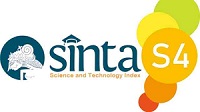PENGARUH PENDEKATAN INTERACTIVE CONCEPTUAL INSTRUCTION (ICI) TERHADAP PENGUASAAN KONSEP DAN AKTIVITAS BELAJAR
Abstract
Penelitian ini dilakukan untuk menganalisis pengaruh pendekatan interaktif pembelajaran konseptual terhadap penguasaan konsep dan aktivitas belajar siswa kelas IV SD Negeri di Kecamatan Laweyan , Surakarta, Indonesia. Penelitian ini merupakan penelitian eksperimen dengan rancangan faktorial 2x2 yang terdiri dari dua kelompok , yaitu eksperimen I (n = 119) dan eksperimen II (n = 117). Instrumen penelitian yang digunakan adalah soal penguasaan konsep berupa esai dan lembar observasi aktivitas. Siswa kelompok eksperimen I mengungguli teman-temannya di kelompok eksperimen II akibat penerapan pendekatan ICI dengan media pembelajaran yang berbeda. Terjadi peningkatan penguasaan konsep yang signifikan pada kedua kelompok eksperimen. Berdasarkan hasil pengujian hipotesis menggunakan two-way ANOVA dapat disimpulkan bahwa: (1) penerapan pendekatan ICI dengan media video lebih efektif dalam meningkatkan penguasaan konsep; (2) penerapan pendekatan ICI terhadap tingkat aktivitas pembelajaran tidak berpengaruh terhadap penguasaan konsep; (3) tidak ada interaksi antara media dan aktivitas pembelajaran terhadap penguasaan konsep dalam penerapan pendekatan ICI. Berdasarkan temuan, penelitian ini menyarankan rekomendasi bagi guru untuk merumuskan cara-cara mengaktifkan semua siswa dalam belajar dan memperhatikan tingkat aktivitas siswa dalam menentukan pendekatan dan media yang tepat.
Full Text:
PDF (Bahasa Indonesia)References
Anderson, & Krathwohl. (2010). Kerangka Landasan Untuk Pembelajaran, Pengajaran, Dan Asesmen. Pustaka Pelajar.
Arisanti, W. O. L., Sopandi, W., & Widodo, A. (2016). Analisis penguasaan konsep dan keterampilan berpikir kreatif siswa SD melalui Project Based Learning. EduHumaniora, 8(1), 82–95.
Aryani, W. D., Suhendi, E., Suyana, I., Samsudin, A., & Kaniawati, I. (2019). Effectiveness of implementation interactive conceptual instruction (ICI) with computer simulation to overcome students’ misconceptions about newton’s law of gravitation. Journal of Physics: Conference Series, 1280(5), 0–7. https://doi.org/10.1088/1742-6596/1280/5/052011
Aslan, A., & Demircioğlu, G. (2014). The effect of video-assisted conceptual change texts on 12 th grade students’ alternative conceptions: The Gas Concept. Procedia - Social and Behavioral Sciences, 116, 3115–3119. https://doi.org/10.1016/j.sbspro.2014.01.718
Avcı, D. E., Kara, İ., & Karaca, D. (2012). Fen Bilgisi Ö ğ retmen Adaylar ı n ı n İş Konusundaki Kavram Yan ı lg ı lar ı * Fen Bilgisi Öğretmen Adaylarının İş Konusundaki Kavram Yanılgıları * Misconceptions of Science Teacher Candidates About Work Abstract. Pamukkale Üniversitesi Eğitim Fakültesi Dergisi, 31, 27–39.
Bao, L., & Fritchman, J. C. (2021). Knowledge integration in student learning of Newton’s third law: Addressing the action-reaction language and the implied causality. Physical Review Physics Education Research, 17(2), 20116. https://doi.org/10.1103/PhysRevPhysEducRes.17.020116
Barani, G., Mazandarani, O., & Rezaie, S. H. S. (2010). The effect of application of picture into picture audio- visual aids on vocabulary learning of young Iranian ELF learners. Procedia - Social and Behavioral Sciences, 2(2), 5362–5369. https://doi.org/10.1016/j.sbspro.2010.03.874
Buber, A., & Unal, C. (2017). The effect of learning activities based on argumentation on conceptual understanding of 7th graders about “Force and Motion” unit and establishing thinking friendly classroom environment. European Journal of Educational Research, 6(3), 367–384. https://doi.org/10.12973/eu-jer.6.3.367
Buckley, C. A., Pitt, E., Norton, B., & Owens, T. (2010). Students ’ approaches to study , conceptions of learning and judgements about the value of networked technologies. Active Learning in Higher Education, 2(1), 55–65. https://doi.org/10.1177/1469787409355875
Bustillo, J., & Garaizar, P. (2016). Using Scratch to foster creativity behind bars: Two positive experiences in jail. Thinking Skills and Creativity, 19, 60–72. https://doi.org/10.1016/j.tsc.2015.08.003
Çaliskan, S. (2011). Instruction of learning strategies: Effects on conceptual learning, and learning satisfactions. Asia-Pacific Forum on Science Learning and Teaching, 12(1), 1–26.
Castro, S. A., Amador, J., & Bragelman, J. (2018). Facilitating video-based discussions to support prospective teacher noticing. Journal of Mathematical Behavior, 1–18. https://doi.org/10.1016/j.jmathb.2018.11.002
Chittaro, L. (2017). A comparative study of aviation safety briefing media: card, video, and video with interactive controls. Transportation Research Part C: Emerging Technologies, 85, 415–428. https://doi.org/10.1016/j.trc.2017.10.007
DeLozier, S. J., & Rhodes, M. G. (2016). Flipped classrooms : a review of key ideas and recommendations for practice. Educ Psychol Rev, 29(1), 141–151. https://doi.org/10.1007/s10648-015-9356-9
Erol, O., & Adile, A. (2017). The effects of teaching programming with scratch on pre-service information technology teachers motivation and achievement. Computers in Human Behavior. https://doi.org/10.1016/j.chb.2017.08.017
Farrokhnia, M., Pijeira-díaz, H. J., Noroozi, O., & Hatami, J. (2019). Computer-supported collaborative concept mapping : The e ff ects of di ff erent instructional designs on conceptual understanding and knowledge co-construction. Computers & Education, 142, 1–15. https://doi.org/10.1016/j.compedu.2019.103640
Greeno, J. G., & Engeström, Y. (2013). Learning In Activity. In The Cambridge Handbook of the Learning Sciences (2nd edition (pp. 1–39).
Guskey, T. R. (2015). Mastery Learning. In International Encyclopedia of Social & Behavioral Sciences (Second Edi, Vol. 14, pp. 752–759). Elsevier. https://doi.org/10.1016/B978-0-08-097086-8.26039-X
Hapsari, A. S., Hanif, M., Gunarhadi, & Roemintoyo. (2019). Motion graphic animation videos to improve the learning outcomes of elementary school students. European Journal of Educational Research, 8(4), 1245–1255. https://doi.org/10.12973/eu-jer.8.4.1245
Hillyard, C., Gillespie, D., Littig, P., Hillyard, C., Gillespie, D., & Littig, P. (2010). University students’ attitudes about learning in small groups after frequent participation. Active Learning In Higher Education, 2(1), 9–20. https://doi.org/10.1177/1469787409355867
Ilhan, M., & Gezer, M. (2017). A Comparison of the Realibility of the SOLO and Revised Bloom’s Taxonomy-Based Classifications in the Analysis of the Cognitive Levels of Assessment Questions. Pegem Egitim ve Ogretim Dergisi, 7(4), 637–662. https://doi.org/10.14527/pegegog.2017.023
Johan, H., Suhandi, A., Wulan, A. R., & Herawati, A. (2018). Enhancing mastery of earth science concept of prospective physics teachers through interactive conceptual instruction supported by visualization and GRADS. Jurnal Pendidikan IPA Indonesia, 7(4), 435–441. https://doi.org/10.15294/jpii.v7i4.9799
Khalid, R., Mokhtar, A. A., Omar-fauzee, M. S., Don, Y., & Mahyuddin, A. (2013). The learning styles and academic achievements among arts and science streams student. International Journal of Academic Research in Progressive Education and Development, 2(2), 68–85.
Kim, S., Raza, M., & Seidman, E. (2019). Improving 21st-century teaching skills: The key to effective 21st-century learners. Research in Comparative and International Education, 14(1), 99–117. https://doi.org/10.1177/1745499919829214
Koll, S. Van, & Rietz, C. (2016). Effects of Web-Based Feedback on Students ’ Learning. Intternational Journal of Teaching and Learning in Higher Education, 28(3), 385–394.
Marcelino, M. J., Pessoa, T., Vieira, C., Salvador, T., & Mendes, A. J. (2018). Learning computational thinking and scratch at distance. Computers in Human Behavior, 80, 470–477. https://doi.org/10.1016/j.chb.2017.09.025
Mayer, R. (2002). Rote versus meaningful learning. Theory into Practice, 41(4), 226–232. https://doi.org/10.1207/s15430421tip4104
Meltzer, D. E., Thornton, R. K., Meltzer, D. E., & Thornton, R. K. (2012). Resource Letter ALIP – 1 : Active-Learning Instruction in Physics. American Journal of Physics, 80(6), 478–496. https://doi.org/10.1119/1.3678299
Meyer, O. A., Omdahl, M. K., & Makransky, G. (2019). Investigating the effect of pre-training when learning through immersive virtual reality and video: A media and methods experiment. Computers and Education, 140, 1–17. https://doi.org/10.1016/j.compedu.2019.103603
Miranda, J., Navarrete, C., Noguez, J., Molina-Espinosa, J. M., Ramírez-Montoya, M. S., Navarro-Tuch, S. A., Bustamante-Bello, M. R., Rosas-Fernández, J. B., & Molina, A. (2021). The core components of education 4.0 in higher education: Three case studies in engineering education. Computers and Electrical Engineering, 93(June). https://doi.org/10.1016/j.compeleceng.2021.107278
Mujasam, Renita, S. G. M., & Allo, A. Y. T. (2018). Activity and progress of learning with two stay two stray (TS-TS) cooperative model on harmonic vibration. Journal of Turkish Science Education, 15(Special Issue), 59–66. https://doi.org/10.12973/tused.10257a
Patriot, E. A., Suhandi, A., & Chandra, D. T. (2017). Effect of Implementation Interactive Conceptual Instruction with Multi Representation Approach To Improve Levels of Understanding on Work and Energy Subject Matter. 4th ICRIEMS Proceedings, 21–28.
Samsudin, A., Suhandi, A., Rusdiana, D., Kaniawati, I., & Coştu, B. (2016). Investigating the effectiveness of an active learning based-interactive conceptual instruction ( ALBICI ) on electric field concept. Asia-Pacific Forum on Science Learning and Teaching, 17(1).
Sands, D. (2014). Concepts and conceptual understanding : what are we talking about ? The Higher Education Academy, 10(1), 7–11. https://doi.org/10.11120/ndir.2014.00030
Sardiman. (2014). Interaksi & Motivasi Belajar Mengajar. Rajawali Pers.
Sawyer, R. K. (2018). The New Science of Learning. In The New Science of Learning (pp. 1–18). https://doi.org/https://doi.org/10.1017/CBO9781139519526.002
Sedrakyan, G., Malmberg, J., Verbert, K., & Paul, A. (2018). Linking Learning Behavior Analytics and Learning Science Concepts: Designing a Learning Analytics Dashboard for Feedback to Support Learning Regulation. Compueter in Human Behavior, 107, 1–26. https://doi.org/10.1016/j.chb.2018.05.004
Shabiralyani, G., Hasan, K. S., Hamad, N., & Iqbal, N. (2015). Impact of visual Aids in enhancing the learning process case research : District Dera Ghazi Khan. Journal of Education and Practice, 6(19), 226–234.
Smith, C. M., & Sodano, T. M. (2011). Integrating lecture capture as a teaching strategy to improve student presentation skills through self-assessment. Active Learning in Higher Education, 12(3), 151–162. https://doi.org/10.1177/1469787411415082
Sugiyono. (2016). Metode Penelitian Pendidikan Pendekatan Kuantitatif, Kualitatif, dan R&D. Alfabeta.
Suryani, E., Rusilowati, A., & Wardono. (2016). Analisis pemahaman konsep IPA siswa SD menggunakan Two-Tier Test melalui pembelajaran konflik kognitif. Journal of Primary Education, 5(1), 56–65. https://doi.org/10.15294/JPE.V5I1.12893
Tekkumru-kisa, M., & Stein, M. K. (2017). A framework for planning and facilitating video-based professional development. International Journal of STEM Education, 4(28), 1–18. https://doi.org/10.1186/s40594-017-0086-z
Toran, M., Aydin, E., & Etguer, D. (2015). Investigating the effects of STEM enriched implementations on school readiness and concept acquisition of children. Ilkogretim Online - Elementary Education Online, 19(1), 299–309. https://doi.org/10.17051/ilkonline.2020.
Tsai, C. (2018). Improving students’ understanding of basic programming concepts through visual programming language: The role of self-efficacy. Computers in Human Behavior, 1–19. https://doi.org/10.1016/j.chb.2018.11.038
van Es, E. A., Tunney, J., Goldsmith, L. T., & Seago, N. (2014). A framework for the facilitation of teachers’ analysis of video. Journal of Teacher Education, 65(4), 340–356. https://doi.org/10.1177/0022487114534266
Verdine, B. N., Golinkoff, R. M., Hirsh-Pasek, K., & Newcombe, N. S. (2014). Finding the missing piece: Blocks, puzzles, and shapes fuel school readiness. Trends in Neuroscience and Education, 3(1), 7–13. https://doi.org/10.1016/j.tine.2014.02.005
Vidermanova, K., & Vallo, D. (2015). Practical geometry tasks as a method for teaching active learning in geometry. Procedia - Social and Behavioral Sciences, 191, 1796–1800. https://doi.org/10.1016/j.sbspro.2015.04.421
Wahyuni, S., Sudarisman, S., & Karyanto, P. (2013). Pembelajaran Biologi Model Poe (Prediction, Observation, Explanation) Melalui Laboratorium Riil Dan Laboratorium Virtuil Ditinjau Dari Aktivitas Belajar Dan Kemampuan Berpikir Abstrak. Inkuiri, 2(03), 269–278.
Wang, M. M., Kirschner, P. A., Bridges, S. M., & Derry, S. J. (2016). Proceedings of the Workshop on Computer-Based Learning Environments for Deep Learning in Inquiry and Problem-Solving Contexts. Pre-Conference Workshop at The12th International Conference of the Learning Sciences, 1–60.
Wardani, F., Khairuddin, K., & Merta, I. W. (2020). Perbedaan Prestasi Belajar IPA Antara Siswa yang Menggunakan Fotografi. 465(Access 2019), 17–19.
Wiana, W., Barliana, M. S., & Riyanto, A. A. (2018). The effectiveness of using interactive multimedia based on motion graphic in concept mastering enhancement and fashion designing skill in digital format. International Journal of Emerging Technologies in Learning, 13(2), 4–20. https://doi.org/https://doi.org/10.3991/ijet.v13i02.7830
Widiyanti, F., Indriyanti, D. R., & Ngabekti, S. (2015). The effectiveness of the application of scientific literacy-based natural science teaching set toward the students’ learning activities and outcomes on the topic of the interaction of living organism and environment. Jurnal Pendidikan IPA Indonesia, 4(1), 20–24. https://doi.org/10.15294/jpii.v4i1.3496
Yukselturk, E., & Altiok, S. (2016). An investigation of the effects of programming with Scratch on the preservice IT teachers’ self-efficacy perceptions and attitudes towards computer programming. British Journal of Educational Technology, 48(3), 789–801. https://doi.org/10.1111/bjet.12453
Zhang, W., & Liu, H. (2017). Learning picture quality from visual distraction: psychophysical studies and computational models. Neurocomputing, 1–24. https://doi.org/10.1016/j.neucom.2017.03.054
Zhang, Y., Kwong, S., & Wang, S. (2020). Machine learning based video coding optimizations: A survey. Information Sciences, 506(2020), 395–423. https://doi.org/10.1016/j.ins.2019.07.096
DOI: https://doi.org/10.25134/pedagogi.v9i2.6567
Refbacks
- There are currently no refbacks.

This work is licensed under a Creative Commons Attribution-ShareAlike 4.0 International License.











